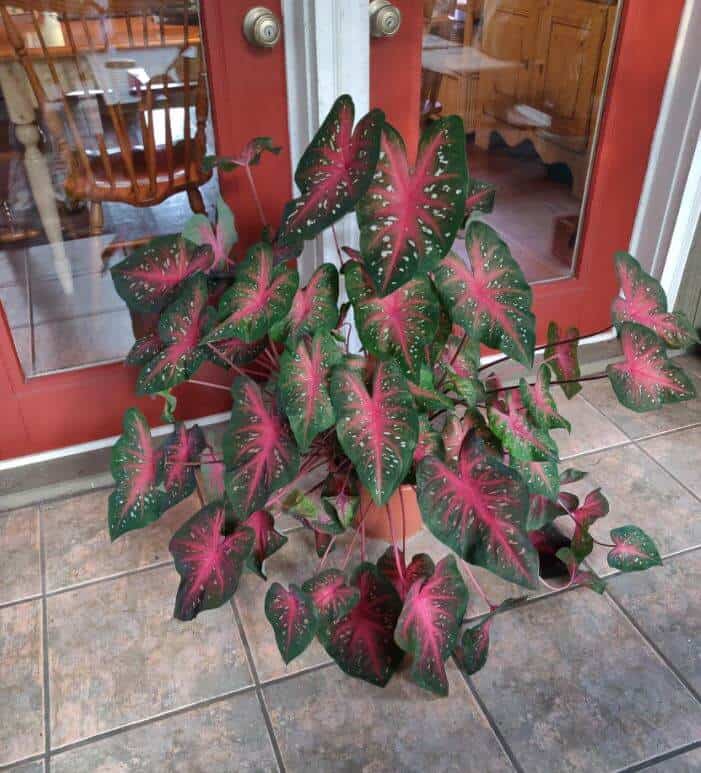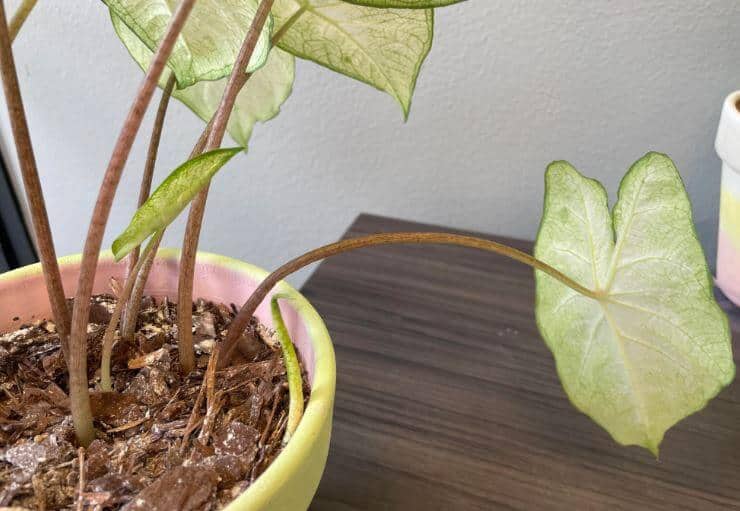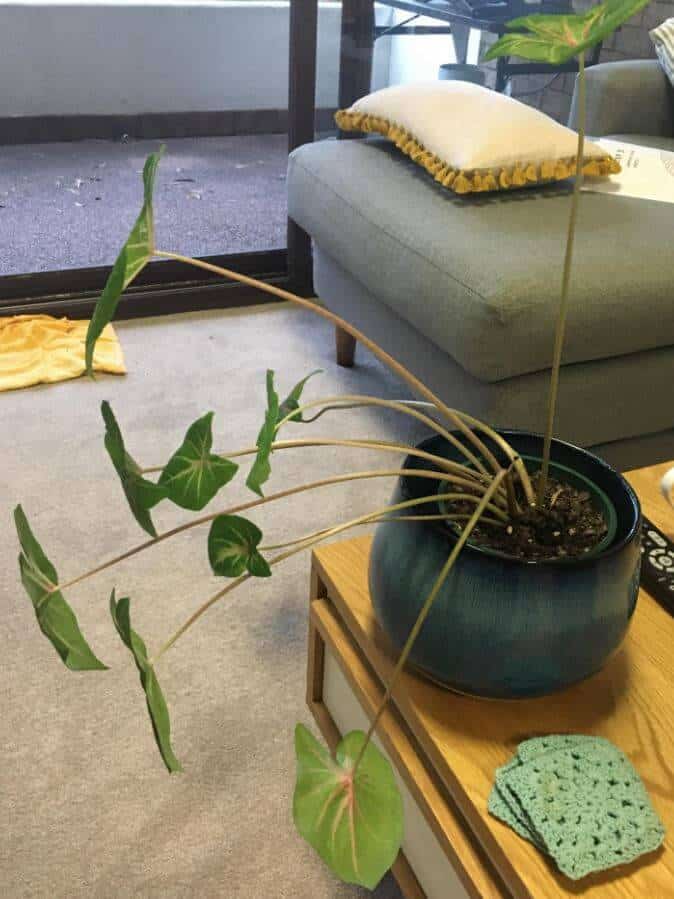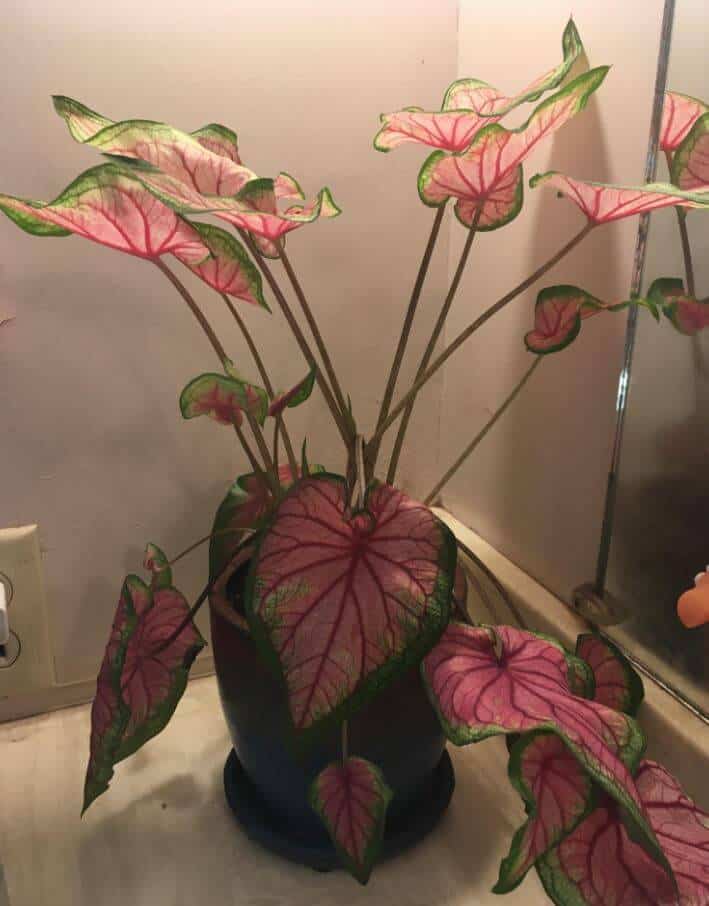Last Updated on August 25, 2023 by a Friendly Gardener
The vibrant heart-shaped foliage of the Caladium plant can be a real showstopper, but as lovely as these plants are, they are equally communicative. So, if the leaves of your Caladium begin to droop, you know your plant has an issue that requires your intervention.
The Caladium is a tropical evergreen perennial that will show any distress it is experiencing, and drooping leaves are a common symptom. The causes of Caladium leaves drooping might include excess direct sunlight, improper watering, inadequate environmental humidity, fertilizer salt buildup in the soil, cold drafts, or your plant may be root-bound.
As soon as Caladium foliage droops, know that something needs to be adjusted, as the drooping is often one of the earliest signs of a problem. For successful treatment, it’s essential to identify what is stressing your plant to the point of causing it to droop. Here, we examine potential causes and solutions to make your Caladium healthy and perky again.
A Drooping Caladium

If your Caladium is drooping in the cooler seasons, such as winter, this may be a normal reaction to temperatures below 65°F due to cold stress. But when drooping happens at other times of the year when temps are not falling, know that drooping caladium foliage is abnormal and generally indicates that something in the environment or care routine is disturbing the plant.
Even a slight change in your care routine can stress this houseplant, causing drooping, discoloration, yellowing foliage, stem wilting, or slow growth. As a South and Central American native, the tropical Caladium likes a warm environment similar to its native habitat so that any temperature fluctuation can disturb your plant. If you note minimal foliage drooping, it’s important to intervene immediately to prevent massive drooping, which can damage the plant.
Why Is My Caladium Drooping?

There are a variety of causes for drooping Caladium leaves; here, we examine some of the more common reasons.
Overwatering
Caladium prefers moist soil, but that doesn’t mean it enjoys sitting in saturated soil beds. Consistently moist soil is essential to your plant’s health. Yet, excess water in the soil can prevent the plant’s tubers from supplying nutrients to stems and foliage because it impedes much-needed oxygen from reaching the root system, essentially drowning it. If tuber rot sets in, the stems and leaves will droop.
What to do
Remove the plant from its container and soil to inspect the roots. If it appears root rot has set in, remove mushy, dark roots from healthy ones. Rinse the remaining healthy roots in tepid water and apply a fungicide. Place the plant in a clean container and fresh potting soil. Avoid watering until foliage shows some sign of improvement. In the future, use a moisture meter to gauge soil moisture content. Two to three inches of water weekly should be fine during the growing season. In the fall and winter, water once every three weeks when the soil bed surface has dried.
Underwatering

The Caladium is intolerant of drought, so it will suffer if the soil bed dries out or is compacted, preventing water and air from arriving at the root system. The Caladium will enter dormancy, with foliage turning crispy and then drooping. Yellowing or browning leaf edges are among the initial signs of underwatering.
What to do
Place the plant in a water-filled saucer to permit gradual absorption, or immerse your plant in a tub or sink filled with water to water deeply.
Water the plant weekly in spring and summer and mist plant leaves if temperatures rise above 75°F. Use a soil moisture meter to keep the situation under control. Consider mulching your plant with a natural mulch such as straw to aid soil moisture retention.
Excessive Sunlight
The Caladium does not do well in direct sunlight. It is a shade-loving creature that prefers dappled or indirect sunlight exposure. Your Caladium will do best when provided eight hours of bright, indirect sunlight exposure. Exposing your plant to bright, direct sunlight can result in leaf scorching and bleaching with edges that turn yellow or brown and then white.
Inadequate light can also cause drooping as it will inhibit photosynthesis.
What to do
Move your plant to a shady spot and keep it several feet from sources of direct sunlight, like windows and doors. Prune off damaged leaves and increase humidity in the immediate area of the plant. Increase watering slightly to rehydrate your Caladium.
Environmental Temperature
As a tropical lover of warm locations, the Caladium will react badly if left in cool temperatures. It will also suffer from cool drafts when environmental temperatures fall below 65°F. Temps below 50° F can be fatal. Prolonged exposure to cool temperatures can cause Caladium drooping, stunted growth, and yellowing leaves.
Temperatures of 85°F and above can deplete humidity and cause your plant to suffer.
What to do
If your plant is outdoors, move it inside. Cover caladiums with a frost blanket or plastic to provide some insulation. Cover the soil bed with straw or pine mulch. Reduce both watering and fertilization until leaves stop drooping. Keep your plant in temps ranging from 70° to 85° F. all year. Avoid placing plants near heating or air conditioning vents.
Excessive Fertilization

A well-balanced liquid fertilizer is recommended during the growing season. Still, overfeeding can cause a salt buildup in the soil bed, disturbing root systems and preventing them from absorbing and sending nutrients throughout the plant. White or yellow crusts on the soil indicate a salt buildup.
What to do
Deep water or flush your plant’s soil and container so salts run out through drainage holes. Prune off any damaged leaves. Depending on the amount of crust, repot your plant in fresh soil. Hold off on further feeding until leaves stop drooping.
Inadequate Humidity
Caladium plants enjoy moderate humidity in their natural habitats, requiring average humidity where they are cultivated. Low humidity, especially during summer months, can cause leaves to lose turgidity. Brown, crispy drooping leaves generally indicate a humidity issue.
What to do
Maintain a humidity level of approximately 50% in the area of the plant. If you need to increase humidity, use a space humidifier, a pebble tray beneath your plant, or group plants to achieve a microclimate through shared transpiration. Mist foliage in the early morning.
A Final Thought

Also, consider that your Caladium may be root-bound and require a larger pot to host the root system. Caladiums should be repotted at least once every two years in fresh soil and a container approximately two inches larger.
Improper potting mix can also disturb your plant. Caladiums need well-draining, loose soil sufficiently fertile to contain essential nutrients. Add some perlite to a rich potting mix to guarantee drainage and aeration.
Finally, consider seasonal die-back. The Caladium is a perennial that will actively grow in the spring and summer. It will then die back or enter dormancy. This is a natural process that cannot be prevented. Let your plant rest until next spring.

